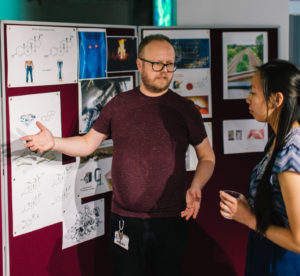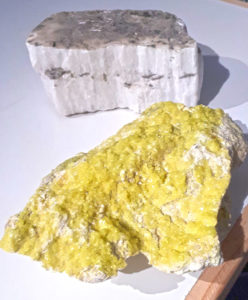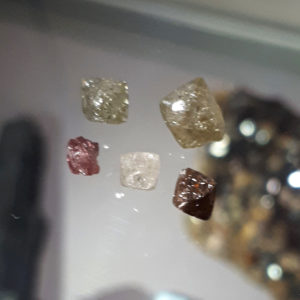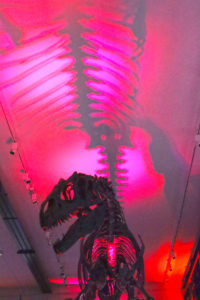 “For more than four months now, I haven’t seen the inside of my office on campus. Visiting the garden centre was among the most exciting things I’ve physically done – in stark contrast to my ‘jet set’ virtual life on Zoom where I have been having meetings with other researchers all over Europe but also from Texas, South Africa and Saudi Arabia! Therefore, I’ve got very fond memories of my last public engagement event at the Lapworth Lates. Based in the beautiful Lapworth Museum of Geology on campus, I had the chance to present my research to the public. In the middle of February, the museum was flooded by 200 people and there was a constant stream of visitors to my exhibition booth from the opening at 7pm until way after closure at 10pm.
“For more than four months now, I haven’t seen the inside of my office on campus. Visiting the garden centre was among the most exciting things I’ve physically done – in stark contrast to my ‘jet set’ virtual life on Zoom where I have been having meetings with other researchers all over Europe but also from Texas, South Africa and Saudi Arabia! Therefore, I’ve got very fond memories of my last public engagement event at the Lapworth Lates. Based in the beautiful Lapworth Museum of Geology on campus, I had the chance to present my research to the public. In the middle of February, the museum was flooded by 200 people and there was a constant stream of visitors to my exhibition booth from the opening at 7pm until way after closure at 10pm.

I prepared very graphical print-outs with little to no text. I also had a number of props to show and to be touched by the audience – a model of the steroid backbone for example. However, the coolest thing I was able to do was to link my biomedical research to minerals from the collection. The director of the museum, Jonathan Clatworthy, had great trust in us, the exhibiting scientists and artists, and provided us with superb specimens to exhibit at our booths. When people think of sulfur, what usually comes to mind is the smell of sulfur fumes and perhaps the vivid shades of yellow of sulfur itself. I had a decent chunk of sulfur mineral to show to visitors. Actually, I was surprised myself that even this old museum rock was actually slightly smelly of rotten eggs. How interesting!
In nature, a lot of sulfur occurs as oxidised sulfate. The sulfate mineral CaSO4 x 2 H2O, also known as gypsum, nicely illustrates the properties of sulfate in the human cell. It’s “lazy” sulfate; it needs activation to do anything chemical. No need to mention that I also had a good rock of gypsum at hand. Please remember, gypsum is the main component of plaster – and you wouldn’t have done much with your arm or leg in plaster, would you? In this analogy, it becomes obvious that sulfate needs to be activated, before it can be attached to one of many different acceptor molecules. Once this happens, the molecule is said to be ‘sulfated’.
Steroid hormones are an important group of acceptor molecules that become sulfated. Steroids are biologically very powerful signalling compounds, regulating the balance of chemicals in the body. They direct the general growth of the body as well as the development of sex characteristics like ovaries or testes. The steroid ‘backbone’ is a highly stable structure made from carbon, not unlike diamonds which are also made of carbon… and so again, I had raw diamonds to show people. Although this time Jon asked me to just show them without giving them out to anyone to handle. Which is understandable, as even raw diamonds are valuable and not something the museum would want to lose!
The sulfate is kind of a cap that is put on the steroid for ease of transport and as an additional precaution. Removal of the sulfate from a steroid molecule re-activates that steroid. At Lapworth Lates, I compared the sulfate at a steroid to a crown cap on a beer bottle, which everyone seemed to understand. Sulfated steroids are found in abundance in our human circulation system. This sulfate shuttle enables steroid signalling in distant tissues that otherwise wouldn’t be able to make these hormones by themselves. It is this system of sulfate activation, transfer and removal that I have studied in depth for several years, both mechanistically and also in an applied setting. We try to understand new pathways and to learn new things; and ultimately, we aim to develop new tools for analysis, which will help us try to open new therapy options for steroid excess disorders such as steroid-dependent cancer types such as breast or prostate cancer or polycystic ovary syndrome (PCOS).

I thoroughly enjoyed the direct contact I was able to have with so many members of the public as well as their genuine interest in my research – which is personally highly motivating to get feedback on. I also learned more how to pitch my research to a completely different audience. All in all, I’m glad I didn’t miss the experience of being in the middle of the crowds at the Lapworth Lates! Let’s hope that such events are going to happen again soon. In the meantime, I’m preparing an outreach presentation for A-level kids, via Zoom, sitting in my bedroom!”
– Jonathan Mueller
Image credit: Thanks to Greg Milner Photography for the image featured at the very top of the page.
